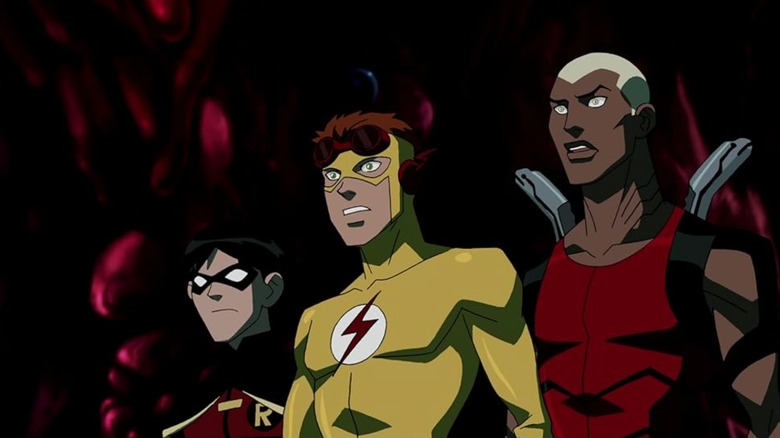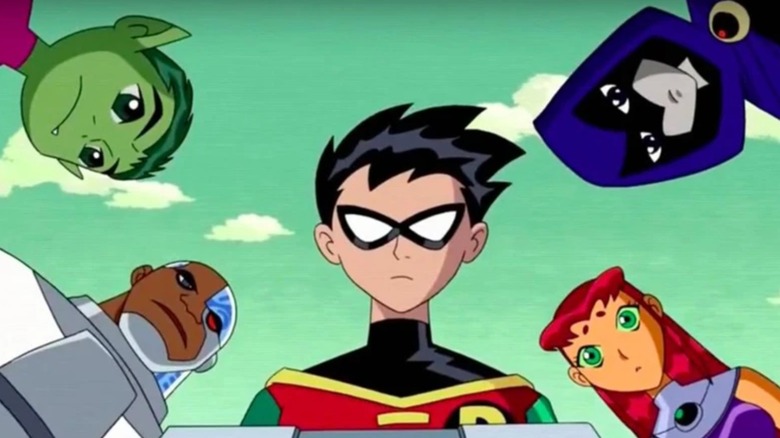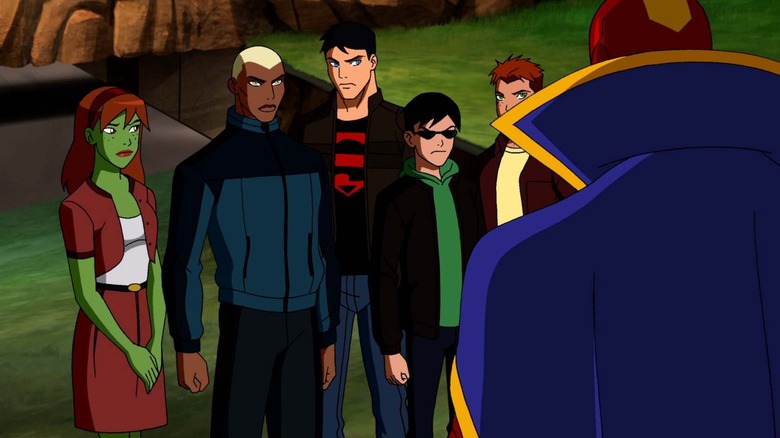Why Young Justice's Creators Didn't Even Want To Make The Show At First
We may receive a commission on purchases made from links.
Does "Young Justice" have a future? The animated show hasn't been officially canceled, but it hasn't been picked up for a fifth season either. DC Studios Co-Presidents James Gunn and Peter Safran may not want the brand confusion, since they said back in 2023 that DC cartoons will be in continuity with, and feature actors from, their new cinematic DC Universe.
If "Young Justice" fans want more stories from the series, though, they have another option: from 2011 to 2013, series creator Greg Weisman co-wrote a 26-issue "Young Justice" tie-in comic (and in 2023, a six-issue miniseries "Young Justice: Targets"). The comic's stories are not essential to the series, but they are considered canon to it. For instance, issues #11-13 tell the origin of Clayface (Nolan North), leading into the cold open of episode 8, "Downtime," where he's fighting the show's young heroes.
In the second trade paperback collection, "Training Day," Weisman revealed some surprising information: he and co-creator Brandon Vietti were at first "not particularly enthusiastic" when developing the show. As Weisman recounted, Warner Bros. Animation President Sam Register recruited him and Vietti in 2009 to make a new DC show, but the concept left them stumped.
"We were more than a little intimidated by the fact that — with 'Justice League Unlimited' and 'Teen Titans' fresh in the minds of fans — another DC superhero-team show would be a hard sell to an audience who had already seen that kind of thing before, recently and successfully."
Both "Justice League Unlimited" and "Teen Titans" finished their runs on Cartoon Network in 2006. "JLU" was the finale to the beloved DC Animated Universe that started back with 1992's "Batman: The Animated Series" and kept a consistent creative team (writer/animator Bruce Timm, voice director Andrea Romano, actor Kevin Conroy as Batman, etc.) "Teen Titans" is and was a cultural touchstone for kids who watched it in its original run; there's a reason it technically still lives on to this day as "Teen Titans Go!"
Both "Teen Titans" and "Young Justice" have the same pitch about following the sidekicks and teen heroes of the DC Universe on a team together. That must have made Weisman and Vietti especially hesitant. Their solution was to make "Young Justice" as different as possible from "Teen Titans," with a unique hook to set it apart from "Justice League" too. Weisman explained:
"Brandon suggested making the new show about the Justice League's covert ops team: 'Make it a spy series first. A teen drama second. A superhero show third.' Suddenly, it felt like we had a fresh approach."
Young Justice set itself apart from the Cartoon Network Teen Titans
Developed by Glen Murakami, "Teen Titans" was an action comedy series. The art style and artist Derrick J. Wyatt's character designs took influence from anime (note the characters' round faces, triangle chins, and big eyes). The Titans behaved like they were in an anime too, i.e., becoming "chibi" (super-deformed) and screaming loudly during comedy hits. There was a wish-fulfillment aura to the series; the Titans were best friends living together with no parents and being superheroes, i.e., the dorkiest dream of every little kid watching.
"Teen Titans" could get dark, granted. Season 2 adapted comic story "The Judas Contract," where new Titan recruit Terra (Ashley Johnson) betrays them to their enemy, Slade (Ron Perlman). In the episode "Spellbound," Raven (Tara Strong) falls for the spirit of a handsome wizard trapped in a spellbook, a creepy warning to kids about the dangers of trusting friendly strangers you meet online. These were exceptions to the rule, though.
On "Young Justice," the rule was what had been the exception on "Teen Titans." In the series premiere, sidekicks Robin (Jesse McCartney), Aqualad (Khary Payton, who'd been Cyborg on "Titans,"), and Kid Flash (Jason Spisak) convince their mentors on the Justice League that they're ready for more responsibility. So, their mentors assign them to a secret team, one that'll handle covert missions too delicate for famous heroes like the Justice League. This is why they're just called "the Team" — their whole purpose is to be discreet, so no "fancy name," as Weisman put it.
Knowing now that Weisman and Vietti thought of "Young Justice" as a spy series really puts the series into perspective, as many of the early standalone episodes feature espionage-centered plots.
In episode 4, "Dropzone," the Team has to infiltrate Santa Prisca, the island nation ruled by Bane (Danny Trejo). In episode 6, "Infiltrator," the Team must guard a scientist being targeted for assassination by the League of Shadows. Episode 11, "Terrors," sees Miss Martian (Danica McKellar) and Superboy (Nolan North) go undercover in Belle Reve prison. There's also a whole arc about a secret mole on the Team during "Young Justice" season 1, which is as "spy thriller" as a show can get. Season 2 builds on that with a running subplot of Aqualad being undercover in the criminal organization run by his father, super-villain Black Manta (Payton).
Young Justice showed what teen and spy dramas have in common
Even the central antagonist of "Young Justice," a conspiracy of power players called The Light, is out of a spy story. In season 3, some of the more secretive heroes, like Batman (Bruce Greenwood,) decide they need their own conspiracy working in the shadows to counter the Light, adding another layer to the espionage.
Clearly, the superhero side of "Young Justice" fits with both the spy thriller and teen drama angles; Weisman proved with his previous cartoon, "The Spectacular Spider-Man," that he could balance cartoon superhero action and love triangles like no one else. What about the teen drama and spy thriller sides of the show? They meld together better than you might expect, too.
What do those genres have in common? People are hiding things from each other. In teen dramas, it's who has a crush on whom. In spy thrillers, it's delicate intelligence. In "Young Justice," it's both! Weisman wrote in his "Training Days" write-up that the major theme of "Young Justice" (after "growing up") is "secrets and lies."
Throughout "Young Justice" season 1, some members of the Team have secrets they hide from everyone. The shapeshifting Miss Martian is not a Green Martian like her uncle J'onn/Martian Manhunter (Kevin Michael Richardson), but a White Martian, a discriminated-against minority on Mars, and she's worried her friends will reject her if they learn the truth.
Superboy isn't a mere clone of Superman, but a genetic mix of Superman and Lex Luthor (Mark Rolston). Artemis (Stephanie Lemelin) comes from a super-villain family; her father is Sportsmaster (Nick Chinlund), and her sister is Cheshire (Kelly Hu). In season 1's penultimate episode "Usual Suspects," the Team finally lay their secrets bare, defusing the Light's attempts at manipulating them.
Some fans would argue (and have told Weisman) that after season 1, "Young Justice" got away from this original pitch. The show kept building out its scope and cast; "Young Justice" often feels like an epic about the entire DC Universe. According to Weisman, that was always the entire idea.
"Our 'Young Justice' would be an adaptation of the entire DC universe — as seen through the eyes of a core group of young heroes," he wrote in "Training Days." I hope that, even as Gunn's DC Universe takes off, Weisman and Vietti find a way to return.


